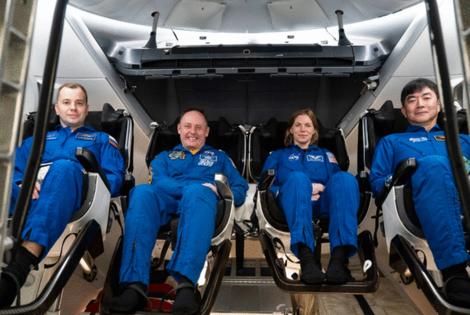NASA targets July 31 for Crew-11 launch while Ax-4 mission won't return until next week
Published in Science & Technology News
There’s nowhere to park right now at the International Space Station for NASA’s next Commercial Crew Program launch, but a slot should clear next week allowing for the launch of Crew-11 as early as July 31.
That’s because the private Axiom Space Ax-4 mission that arrived to the space station two weeks ago could depart as early as Monday, according to an update Thursday from NASA and SpaceX officials.
The station only has room for two of SpaceX’s Crew Dragon spacecraft at a time. Right now it has the newest Dragon named Grace, used by Ax-4 when it launched from Kennedy Space Center on June 25 arriving to the station one day later, and the Crew Dragon Endurance that was used by Crew-10 when it launched from KSC back in March.
Once Ax-4 departs, it will allow for SpaceX to send up Crew Dragon Endeavour flying for a record sixth time launching from KSC’s Launch Pad 39-A as early as 12:09 p.m. on the last day of the month.
“We’re excited for this Dragon, named Endeavour by its first crew, to carry four more astronauts to space in a few weeks,” said Sarah Walker, director of Dragon Mission Management at SpaceX.
It first flew the Demo-2 mission in May 2020 taking up to space NASA astronauts Bob Behnken and Doug Hurley, marking the return of U.S.-based launches for astronauts following the retirement of the Space Shuttle Program in 2011. It has since flown the Crew-2, Axiom-1, Crew-6 and Crew-8 missions.
“This Dragon spacecraft has successfully flown 18 crew members representing eight countries to space already, starting with Bob and Doug,” Walker said.
SpaceX now has five human-rated spacecraft, with Crew Dragon Grace having just made its debut on Ax-4 last month, but Endeavour is the fleet leader. In total, the company’s five Crew Dragons have flown 18 times with 70 humans on board.
NASA Commercial Crew Program manager Steve Stich said teams have had to work through 360 different design units on the Dragon to sign off on it to go beyond the original limit of five flights per spacecraft, although some Dragon parts are certified to fly up to 15 missions.
“We’ve had to go through and do a recertification effort of Dragon, working hand-in-hand with SpaceX to get to six flights,” he said. “This Dragon has a number of upgrades. We continue to try to improve our risk posture for crew safety.”
That includes improved drogue parachutes and a new heat shield.
The launch July 31 would mean a very long transit to the station, a more than 39-hour trip that would dock early Aug. 2. If it can’t make the July 31 launch target, there are options to fly Aug. 1 to 3 and Aug. 5 to 7.
“As always, NASA and SpaceX work closely to ensure that all teams and hardware are ready to fly,” Walker said. “So we still have multiple reviews and tests ahead of us prior to launch, and each one of those gives us an opportunity to step back to talk to each other, to review the data, listen to the hardware and mitigate any risks for a safe flight.”
The four members of Crew-10 would then prep for their return home on Crew Dragon Endurance. They would leave no earlier than Aug. 5 and land in the Pacific for what would be only the third time, following the Fram2 landing earlier this year and the Ax-4 landing coming up shortly.
“We’re also super excited for the first time for Commercial Crew return of our vehicle, our crew, to the West Coast,” Stich said.
For Crew-11, it will send up NASA astronauts Zena Cardman and Mike Fincke, JAXA (Japan Aerospace Exploration Agency) astronaut Kimiya Yui and Roscosmos cosmonaut Oleg Platonov.
Cardman and Fincke’s flights come after having previously assigned flights pulled because of issues with Boeing’s Starliner.
“We have been training together since roughly September of last year,” Cardman said. “We were all in the unique position of actually training with previous crew assignments. What that has meant for us is an incredible bond that is rooted in gratitude and resilience.”
Cardman was supposed to command the Crew-9 flight that flew up to the station last fall with only two instead of the normal four astronauts.
That was because that mission was needed to fly home two NASA astronauts who were left behind on the station by Starliner during its first crewed test flight last summer. NASA ultimately decided to send it home without crew because of safety concerns, and that caused a domino effect that removed Cardman and other other NASA astronaut from their planned Crew-9 flight.
Cardman, a rookie, will command the mission, while Fincke will be making his fourth launch to space having flown on both the space shuttle and two Soyuz missions.
“I’m looking forward to riding on a Dragon,” Fincke said.
Fincke was originally assigned to fly on the first Starliner test flight, and then was bumped to be on what was supposed to be the first operational flight, Starliner-1. But when that flight will happen is up in the air, and reliant on Boeing fixing the safety issues on Starliner. A crewed flight may not happen until late 2026.
Russia’s Platonov is also a first-time flyer while Yui is making his second spaceflight having previously flown on Soyuz.
The quartet is expected to be at the station for at least six months, but could potentially stay closer to eight, Stich said. They will become part of Expedition 73 and then 74 as the International Space Station, which has been crewed nonstop since late 2020.
“We’ll be marking that huge milestone of 25 years of continuous human presence on the space station, and this will be the crew that will be on board to mark that milestone for us coming up,” said NASA’s Bill Spetch, operations integration manager for the space station.
He stumped for the station’s contribution to NASA during that run including its work that helps NASA’s current major objectives.
“We’ve really done an amazing amount of work advancing scientific knowledge, demonstrating new technologies, and really doing all of the things that help prepare us for human exploration of the moon and Mars,” he said. “A lot of the technologies that we’ve proven out on space station over these 25 years are being used in those next-step programs.”
Veteran Fincke, a member of the 1996 class of NASA astronauts, is happy to return for what will be his fourth stay on the station.
“I remember when space station was just pieces here on the ground, and I cannot say how amazed and proud I am of human beings from all over this planet working together pretty darn well,” he said.
---------------
©2025 Orlando Sentinel. Visit at orlandosentinel.com. Distributed by Tribune Content Agency, LLC.







Comments